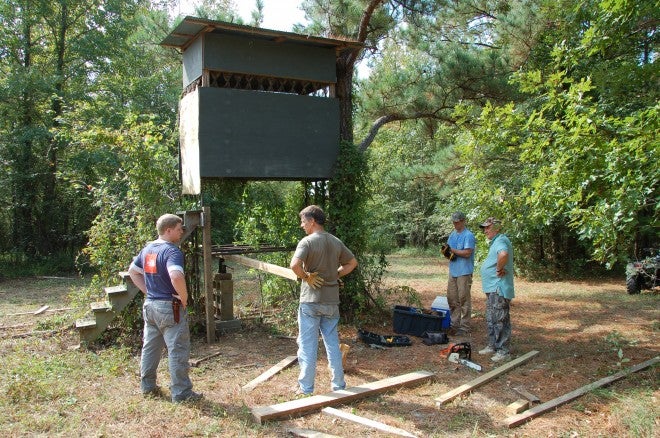Hunting Camp Work – Refreshing Stands
Dr. John Woods 08.26.14

Assessing the status of hunting stands is an annual ritual at deer camp. We usually reserve a full day or two at our camp each year to work on stands. It is amazing what the impact of sitting out in the sun and weather for nearly a year can make on wooden and steel hunting stands.
Our camp has invested in a wide variety of deer hunting stands over the past twenty plus years of property ownership. We have shooting houses that were fabricated from steel warehouse shelving units, covered in plywood and tin shed roofs added. Some of the stands’ “feet” have been sitting in water for 20 years and are finally rusting away. We have had to add new angle iron to strengthen those stands.
We’ve added new tin on top several times, put up fresh camo netting in the windows on an annual basis, repaired swinging doors that pulled out of the hinges, and put up some new sections of plywood along with some paint.
Our resident owner carpenter has added bench seats in nearly all the box stands for hunter comfort. We cut carpet from somebody’s house and lined each floor and some walls to keep things quieter.
Of course, during the work day sessions a good overall cleaning is called for. Some of our own hunters are just slobs, leaving behind candy wrappers and soda cans. In one stand it looking like an owl and some other animal had a battle. Feathers and you-know-what-junk was everywhere. It was purely nasty to say the least, but it had to be cleaned out. I’m glad I was not on that work detail last year.
We have had a number of these heavy shooting houses completely turned over by wind storms and near tornado winds during the year. These are tough to get back upright and put back in place. The steel tubing gets bent and requires extensive repairs, but we have always managed to get them back into service, albeit sometimes a bit tilted or bent in the process.
A good number of our other stands are commercially manufactured tripod, two-seat box stands, or ladder stands. These need a lot of careful inspection for loose bolts, missing bolt nuts, leg straps, and lubrication of the swivel seats.
Any damage from falling limbs has to be repaired. My favorite Family Traditions ladder stand has fallen victim to limb damage twice. Once it bent the seat frame out of whack and it took considerable pounding with a sledgehammer to get it straight. The second time it completely wrecked the fold down shooting bar. I had to fabricate an aluminum bar to strengthen the front part of the fold down piece then I added foam pipe insulation pieces to cover the metal and make it quiet to lean a gun on. I also had to replace the bolts where the bar attached to the stand. All in a day’s work as they say.
Lean up ladder stands need to have their ratchet straps tightened again or replaced if worn. I have tried to put a couple extra notches in the lock gear and had the nylon strap break altogether. These materials age and weaken under tight stress in the sun, wind, rain, and the strain of the stand moving around on the tree.
If you determine the strap(s) needs to be replaced, be sure you get someone else to help hold the base of the stand and wear your safety harness when the stand will be completely unattached from the tree.
If a strap looks weak in color, the edges are frayed, or the ratchet mechanism is frozen up, then it is time to replace it or at least add a new one as a redundant back up. Frankly for me, sometimes it is easier to just add a brand new strap on top or beside the existing one.
Remember these ladder stand straps are your safety line. If you’re up 20 feet off the ground and one of these snaps, it isn’t going to be pretty. Been there, done that. I know most hunters don’t wear a safety harness in a ladder stand with a shooting bar rest in front. You’d be smart if you did, but at least inspect these straps and make sure they are good to go.
Tripod stands have a lot to inspect. Mainly it is the framework of the stand from the ground up. Make sure all the bolts and connectors are tight. Replace any missing ones or others that may have rusted up beyond tightening. Inspect the ladder and its attachment to the upper cage. Make certain the cage frame is stable. Check the seat mount and make sure it turns freely.
Every season we buy fabric covers for the tripod cages. We use burlap simply because it is cheap and will last a whole season. We have the cover attachments down pat using pull ties to quickly line the cage bar tops and just letting the material hang down with the split centered in front of the ladder for easy hunter access.
It may seem like a lot of work to truly inspect every stand you have, but safety and comfort are paramount. And don’t forget if you use lock-on stands with strap-to-the-tree ladder sticks, all that needs maintenance, too. Same for portable climbing stands. Tighten everything up, make them squeak free, and double check all the straps, including your safety harness. You might want to make a trial run on mounting/climbing with these stands to refresh yourself with their use.
Hunting season can be a favorite time of year, but like any other recreational activity it takes a little work to get everything ready. Don’t take short cuts, and don’t skimp on safety.